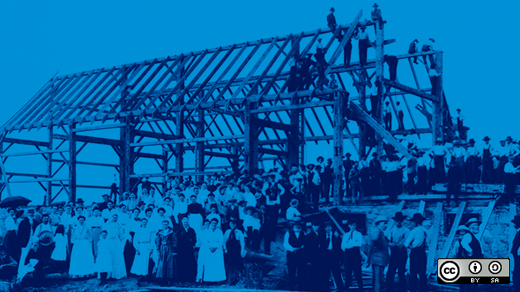When Larry Huston faced the challenge of revving Procter & Gamble's innovation engine to contribute to $5 billion in annual topline growth, he opened up the ranks of the company's vaunted R&D operation to some 1.8 million scientists and researchers around the globe.
When Rob McEwen desperately needed fresh ideas about where and how to drill for gold in his Red Lake mine, he shared his company's proprietary data with thousands of potential prospectors, many of whom had no experience in the industry.
When, earlier this year, Iceland decided to craft an entirely new constitution in the wake of the breakdown of its financial system, the 25-person constitutional council decided to open the process to the public by publishing draft clauses and inviting (and later incorporating) comments and suggestions via a dedicated website, Facebook, Twitter, and YouTube.
It's tempting to conclude that the era of the all-knowing leader with all the answers has given way to a productive populism in which the contribution flows freely to enrich and enliven institutions and individuals alike.
And it's true that the whole world seems to have woken up to the notion that great ideas can come from anywhere (and anyone)--and that it's impossible to predict where the next great one will come from (or to employ all the relevant talent in the world). Exhibit A: the surge of crowdsourcing, mass collaboration, co-creation, and open innovation initiatives seeking to channel those ideas and leverage that talent in every realm of endeavor.
But when it comes to taking those ideas and turning them into a comprehensive view of the future, a compelling set of priorities, and a genuinely involving and ongoing collaboration with a community of stakeholders, there aren't many instructive models.
The fact is, inventing the future of an organization (or "strategic planning" to use the technical term), is still the well-guarded province of the executive elite. The stubborn model is: the boss thinks up the big vision, and the "troops" execute the plan.
Of course, the world is just too complex, change comes too fast, and the challenges we face are too immense (and interconnected), for an insular clique of executives to chart the course of an organization from a blank sheet of paper and sheer brilliance. If the goal is proactive change and continuous renewal, the responsibility for shaping direction must be broadly shared (within and beyond the walls of the organization).
That was the operating assumption when the Wikimedia Foundation set out to get ahead of some pressing challenges and chart a course for the future of Wikipedia and the other projects the nonprofit supports (including Wiktionary, Wikinews, Wikiversity, and Wikimedia Commons). The Wikipedia family of sites is the fifth most popular destination on the Web with more than 500 sites in 270 languages and 400 million visitors each month. Yet, despite continued growth in both contributed articles and readership, the Wikimedia editing community has plateaued near 100,000 active editors and, just as troubling, that pool is disproportionately male, young, and from the Global North.
Addressing those issues and realizing the deeply-held purpose of creating "a world in which every single human can freely share in the sum of all knowledge" would take a radically different approach to the "five year plan." That suited the ambitions of the Wikimedia team (a 50-person organization with just two staffers dedicated to the strategy process), which was driven by the "bigger, more exciting challenge: How do we do strategic planning for a movement?"
That challenge doesn't suggest many best practices, so the team started with a strong conviction that the more open, inviting, and participatory the process, the more powerful the result. The good news: Wikimedia is a volunteer-driven movement made up of hundreds of thousands of people bound by shared goals and practiced in the art of far-flung, large-scale collaboration. Plus, says Phillippe Beaudette, the facilitator for the strategic planning process (and now head of reader relations for Wikimedia), "the Wikimedia community would have hung us by our toenails if we tried to develop a strategic plan any other way."
As recounted in his fascinating story on the mix (co-written by his partner in the strategy process Eugene Eric Kim and Chris Grams), Wikimedia kicked off a year-long experiment in engaging a far-flung community of collaborators in the deep work of asking and answering the questions: Where are we now? Where do we want to go? And, How do we get there? From July 2009 though July 2010, more than 1,000 volunteers took ownership of a dedicated strategy wiki (open to the whole world during the process and now) produced nearly 1500 pages of strategy documents, including 900 proposals, in 50 languages.
Beaudette and Kim didn't take it from there. They made a second appeal to the community to dive into the proposals and supplementary research to categorize, prioritize and form task forces (some 1,000 volunteers were involved in this phase as well). Like all of the strategy work, the task forces were volunteer-led, largely self-directed, and completely public.
The result? A robust strategic plan detailing a set of beliefs, focusing priorities, and related commitments. The plan is available for the world to see (the best part may be the credits page listing the 1000+ co-authors of the plan). Just as important, the thoughtfulness and responsiveness of the process engendered a deep sense of commitment to and ownership of Wikimedia's future. When you involve your community in crafting a path forward, you don't have to spend a lot of time "selling" that vision. Not only are Wikimedians on board, they're taking charge, reports Beaudette. Today, the vision laid out in the strategic plan is unfolding via special projects, ongoing discussions, and self-organizing teams dedicated to specific proposals--from developing the Indian market to launching a "be bold" campaign).
The Wikimedia story may seem like an exception (what company would ever dream of inviting 1,000 customers and community members into the inner sanctum of strategy setting?), but I would suggest it's just a leading indicator. Check out the complete story on the MIX and dig into the treasure trove of documentation on the strategy wiki and soak up the lessons: never underestimate the number of talented individuals willing and able to contribute to your project given the right invitation. You can't open the door just a crack--don't just siphon off ideas, involve people in a process. Never forget that you serve the community--your job is to support them in realizing a shared goal. And remember, the real reward of opening your strategic process isn't that you'll be able to see around more corners, but that you've switched on a powerful current of participatory energy.
And share your participatory energy with us--join Philippe, Eugene, and Chris as contenders for the Management 2.0 Challenge!




Comments are closed.